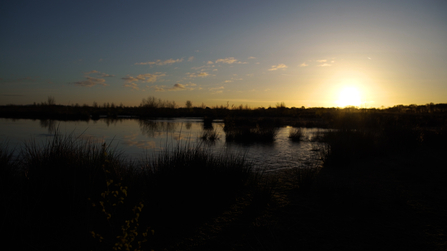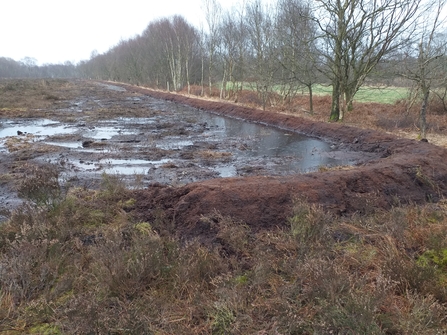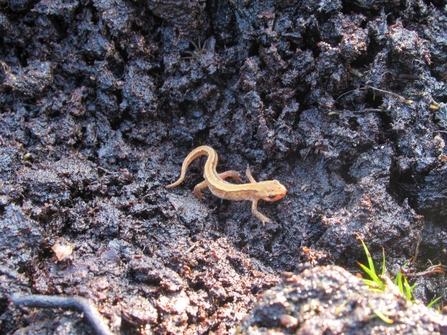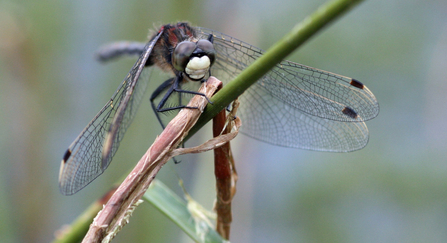Only 13 per cent of peatlands in England are in a near-natural state, and 98 per cent of the lowland raised peat bogs in our region have been lost. Yet peatlands are vital natural resources critical to reversing climate breakdown, able to sequester carbon from the atmosphere and lock it away in their peaty soils. Not only that, but they can also help us weather the effects of climate change: reducing the risk of flooding and fires, and filtering our drinking water.
Save the planet? First we need to save our peatlands
Winmarleigh Moss is home to rare and specialised bog plants including round-leaved sundew and sphagnum mosses

Little Woolden Moss - Standby Productions
Peatlands can also help to address our biodiversity crisis, reversing the terrifying decline in our wildlife by giving rare and specialised plants and animals a place to thrive.
But peatlands only provide us with these vital ecosystem services if we give them some TLC in return. Currently, the majority of the UK’s peatlands are dry, drained and burned; emitting carbon into the atmosphere and becoming hostile environments for the wildlife that used to live there. Thankfully, our peatlands projects are changing this, restoring and reconnecting these precious but fragmented landscapes.

Bunds are used to re-wet peat by forming waterproof barriers of compacted peat.
How do you restore a peatland?
The first and most important stage in peatland restoration is to re-wet the peat. Several methods are used to restore the natural hydrology of our peatlands, including installing bunds (low walls and areas of compacted peat which water can’t pass through) and blocking old drainage ditches.
The next stage is to restore the natural vegetation of the peat. In some cases, this can involve removing invasive scrub woodland which can colonise drained peat, exacerbating the drying effect by taking up even more water through its roots. Other times it can be a case of letting nature take its course and allowing any surviving plants, such as remnant sphagnum mosses, cotton-grasses and heathers to regrow and spread naturally. In most cases, however, restoring peatland vegetation involves planting thousands of plug plants of these native species, usually by hand!
Once these keystone species have established themselves, then comes the fun part… reintroducing some of the less common peatland species such as sundews, bog myrtle, white-beak sedge, bog cranberry, bladderwort, bog rosemary and bog asphodel.

Palmate newt babies were discovered at Little Woolden Moss for the first time in September 2021.
Then it’s time for the animal species. We often find that many species will naturally return to our peatlands as soon as the conditions are right for them. For example, we recently saw palmate newt babies on Little Woolden Moss for the first time. They had previously been living on neighbouring Cadishead Moss, but after years of industrial peat extraction on Little Woolden Moss, the conditions had always been too acidic – until now, that is!
Sadly, some species simply wouldn’t make it on their own, either because they cannot travel that far or due to the sites being too fragmented to allow for safe passage between our restored peatland areas. In this case we have to step in and reintroduce the species ourselves.
The reintroduction of the large heath butterfly
A real success story here has been the reintroduction of the large heath butterfly to Astley Moss in 2020. Habitat destruction had caused the large heath butterfly (locally known as the Manchester argus) to become locally extinct around 150 years ago.

One of the first large heath butterflies to fly on Astley Moss in over 100 years! By Andy Hankinson
However, after years of restoration the lowland raised bog at Astley Moss was finally ready to support a population again, with plenty of cross-leaved heath and hare’s-tail cotton grass growing across the nature reserve. Cross-leaved heath is a lovely species of heather that is main source of nectar for the adult butterfly, and fluffy hare’s-tail cotton-grass is the preferred food source of the caterpillar.
Thankfully, though extinct at Astley Moss, a population of large heath butterflies had managed to survive at Winmarleigh Moss in Lancashire so, following strict IUCN guidelines, just six pregnant female butterflies were collected in the summer of 2019 and then taken to Chester Zoo. Here, they laid their eggs, the caterpillars hatched, and once they had pupated were transported to Astley Moss, where the beautiful butterflies emerged from their cocoons to form the first population in 150 years!
And even better, our reintroduced butterflies successfully bred! This meant that summer 2020 saw the first native population of large heath butterflies fly on Astley Moss since they disappeared all of those years ago.
Carbon farming
As much as we love bogs and are passionate about caring and restoring for the fragments that remain, that isn’t all we do. We are also looking into a number of projects investigating carbon farming and wetter farming. Both of these techniques explore managing land on peat soils in a more sustainable and climate-friendly way, but which can still provide an income for the farmer or landowner.
Irrigation ditches cross the carbon farm maintaining water levels
Our flagship project is the Winmarleigh Carbon Farm, which was created on an area of peatland directly adjacent to Winmarleigh Moss that had been drained and converted for agricultural use in the 1970s. We re-wetted the land and planted a permanent cover crop of sphagnum moss, with the aim to both protect existing soil carbon and soak up (or ‘sequester’) further carbon from the atmosphere.
We have been working with knowledge partners, Manchester Metropolitan University, to analyse greenhouse gas emissions data from the site and have found that in just one year, simply by re-wetting the land, carbon emissions have decreased by 90 per cent. Areas of drained pasture next to the carbon farm are currently emitting 22.2 tonnes of CO2-e per hectare per year, whereas on the carbon farm that has fallen to just 2.2 tonnes of CO2-e per hectare per year, and we expect that once full sphagnum cover has been established the site will become a carbon sink, literally sucking carbon out of the atmosphere.
Simply by re-wetting the land, carbon emissions have decreased by 90 per cent!
And not only that - within just a couple of weeks of the irrigation channels on the carbon farm filling with water, we already had at least five species of dragonfly visiting.
Wetter farming
Also known as paludiculture, wetter farming practices farm crops which thrive in higher water levels. We know that by raising the water table and re-wetting the peat we can halt carbon emissions from peatlands, so we will shortly by starting a pilot project on a field next to Rindle Moss in Greater Manchester where we will trial growing different crops in different water table heights.
What next for our peatlands?
We will continue fighting for the future of our bogs. These climate change challenging, biodiversity boosting, flood fighting super habitats are simply vital for the future of our planet.
We have loads more projects on the go than just those mentioned here. We are:
- Increasing the area of Winmarleigh Moss by restoring a previously wooded area and another that had been converted to farmland.
- Building bog pools at Little Woolden Moss to create habitat for the rare white-faced darter dragonfly.
- Restoring areas of Red Moss in Bolton whilst surveying for and protecting its population of water voles.
- Supporting the creation of a mini-bog by our partners in the Great Manchester Wetlands Partnership at New Moss Wood.
- Installing new footpaths and information boards at Little Woolden Moss to make the site safely accessible for all.
- And even more…

Male white-faced darter dragonfly - Vicky Nall
Want to find out more?
Follow The Lancashire Peatlands Initiative on Facebook to find out everything that our staff and amazing volunteers have been up to.
Want to get involved?
We run regular volunteering sessions on our peatlands - sign up today!
Join the Friends of Chat Moss, a local community group based in Irlam, Greater Manchester

